It’s been a month since my last communication. I’d rather not go longer. Besides, my friends outside of the Western Hemisphere might enjoy more views of the Eastern Pacific – the Coast of Paradise.
Berkeley Hills

Honestly, it’s hard to imagine a more pleasant place to live than the west coast of North America. This path wends its way through the campus hills of the University of California at Berkeley. Berkeley’s campus is huge because it extends up into this range of tall hills. Most of the property is maintained in a natural state. Patches, of course, have been developed into sophisticated physics labs.
 For years, a group of friends from church assembled every Friday to tackle those steep trails, which are actually dirt roads built for emergency fire vehicles. This month witnessed my first foray through them in a few years. I could not have walked it last summer.
For years, a group of friends from church assembled every Friday to tackle those steep trails, which are actually dirt roads built for emergency fire vehicles. This month witnessed my first foray through them in a few years. I could not have walked it last summer.
Even at the beginning of February, flowers were beginning to emerge along the trail. Some rose up from the trail edges like these.
 Others showered down from the overarching trees, like these. They’re California Bay Laurel, called Myrtlewood in Oregon. They’re related to the Mediterranean Bay Laurel, whose leaves feature prominently in Italian cooking. They’re more distantly related to cinnamon and avocado.
Others showered down from the overarching trees, like these. They’re California Bay Laurel, called Myrtlewood in Oregon. They’re related to the Mediterranean Bay Laurel, whose leaves feature prominently in Italian cooking. They’re more distantly related to cinnamon and avocado.
These common trees grow quite tall and enjoy the company of oaks. They branch almost as wildly as the oaks themselves. Most importantly, though, their leaves possess their Mediterranean relative’s aromatic qualities, but with even greater pungency.

They always remind me of Ane Rovetta, the multi-talented artist, storyteller, and ethno-botonist. She also led nature walks with kids. Here she stands in a half crouch, confronting my elementary school class with stories from the old days. It was at the campfire stage at Point Reyes. It was 1988. Yeah, those kids are nowadays deep into middle age.
Anyway, back when she was a budding naturalist leading children, she had wanted her young charges to appreciate the power of the Laurel’s scent. She folded a leaf several times, breaking it along several creases. “Just do this,” she shouted, as she cupped her hands around her nose, sealing her face, and pushing the leaves onto it. She took in a very deep breath, entirely through her nose.
Next thing she knew, she was staring up. From the ground. And the sky was full of worried faces. The powerful leaf aroma had literally knocked her out. At that point, she advised the kids to maybe not smell it quite the same way.
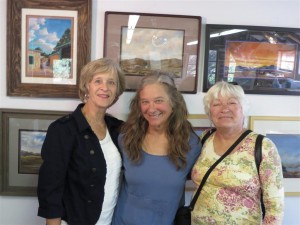 Despite her propensity to take life to the edge, she’s still out there, still painting. I see her every few years, when she holds an open studio sale. And in fact, one of her paintings, with pigments hand-manufactured from the natural materials which she gathers herself, graces my living room. Its organic colors are not likely to fade. Here she is, a year and a half ago, flanked by her two sisters and several examples of her paintings.
Despite her propensity to take life to the edge, she’s still out there, still painting. I see her every few years, when she holds an open studio sale. And in fact, one of her paintings, with pigments hand-manufactured from the natural materials which she gathers herself, graces my living room. Its organic colors are not likely to fade. Here she is, a year and a half ago, flanked by her two sisters and several examples of her paintings.
Lake Chabot
Another collection of bays and oaks lives closer to hand, at Lake Chabot in Castro Valley. Lake Chabot is simply amazing. I think of painter Carl Larsson in Sweden. Once he reached that country home in Dalarna, he never left. His entire career was based on paintings of that home.
I think a photographer could base a lifetime’s career on Lake Chabot. The continually transforming interplay of light on that oak-bay woodland, frosted with eucalyptus, constantly displays new possibilities. Moreover, even when it’s overpopulated on the weekends, it never loses that quiet serenity. It’s a miracle that such a place exists in the midst of a major metropolitan area.
What struck me most this time was the variety of birds. Okay, from memory, here are a couple dozen birds that I’ve spotted at Lake Chabot, listed in compact, easy-to-skip-over form:
 Mallard, Canada and hybrid geese, brown pelican, double-crested cormorant, robin, Stellar’s jay, scrub jay, Caspian tern, several kinds of gulls, Anna’s hummingbird, California towhee, varied thrush, Oregon junco, yellow-crowned sparrow, golden-crowned sparrow, Western bluebird, turkey, turkey vulture, ruby-crowned kinglet, brown creeper, American coot, great blue heron, great egret.
Mallard, Canada and hybrid geese, brown pelican, double-crested cormorant, robin, Stellar’s jay, scrub jay, Caspian tern, several kinds of gulls, Anna’s hummingbird, California towhee, varied thrush, Oregon junco, yellow-crowned sparrow, golden-crowned sparrow, Western bluebird, turkey, turkey vulture, ruby-crowned kinglet, brown creeper, American coot, great blue heron, great egret.
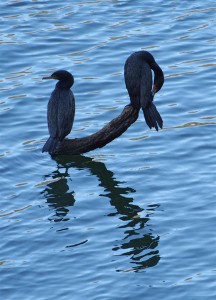 And in addition to all of those, other kinds of ducks appear on Lake Chabot, and some woods bristle with tiny warblers that flit about too quickly to ever see clearly. I’ll probably never identify them until I can learn their songs. And I’ve still never spotted the nesting pair of bald eagles.
And in addition to all of those, other kinds of ducks appear on Lake Chabot, and some woods bristle with tiny warblers that flit about too quickly to ever see clearly. I’ll probably never identify them until I can learn their songs. And I’ve still never spotted the nesting pair of bald eagles.
It’s not just the quantity of birds, but how photogenic they are.
Lake Chabot, like all the lakes in California, is low on water this year, though not as low as some, since it’s maintained as an emergency water supply.
 And yet, rain did fall in California this winter. And here are two bluebirds, hunched down to keep warm, staring defiantly into the windy drops. Look close and you can make out the drops themselves.
And yet, rain did fall in California this winter. And here are two bluebirds, hunched down to keep warm, staring defiantly into the windy drops. Look close and you can make out the drops themselves.
One more picture just to show what light can do at Lake Chabot. It’s some anonymous boatster captured by my long lens, rowing off into a psychedelic sea of electric gold. Click on it for the larger version to catch more details in the abstract patterns – they’re really beautiful.
Portland, Oregon
The rain followed me to Portland. My mother, sister and I immediately embarked on our seasonal pilgrimage to the Pendleton Outlet store in Washougal. This small pier is part of a park on the Columbia River next to the store. The locals walk their children, their dogs, their bicycles, and themselves around on it.
To honor this Californian’s visit, all precipitation ceased. On the right, the clouds summon fallen rainwater from the ground back into the atmosphere. Massive mounds of moisture float overhead like flying fleece. The pier, too, seems to be floating, above the fleece. The locals, sitting on the benches, must feel they are soaring. In the end, the clouds departed, leaving nothing but crystal-clear Northwest Air™.
 For the rest of my stay in Portland, the air remained clear and sunny, like in this picture. The Mountain is Mount Hood, an old volcano, one of many in the area. The falls are Willamette Falls in the Willamette River. This valley marks the end of the famous Oregon Trail, which brought so many settlers from the eastern United States, which displaced, of course, many of the people who had been living there for the previous millennia.
For the rest of my stay in Portland, the air remained clear and sunny, like in this picture. The Mountain is Mount Hood, an old volcano, one of many in the area. The falls are Willamette Falls in the Willamette River. This valley marks the end of the famous Oregon Trail, which brought so many settlers from the eastern United States, which displaced, of course, many of the people who had been living there for the previous millennia.
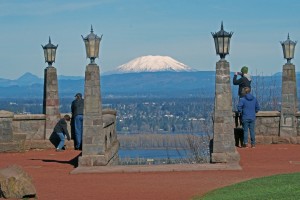 Another local volcano, Mount Saint Helens, used to sport a sharp peak at the top like the others, but then it rather spectacularly blew it all off in 1980, flattening an entire region of forest, and spouting ash all over Portland (and other places). Yeah, those were exciting days! This is the view from “Rocky Butte,” a tall promontory in Northeast Portland not far from my family’s homes.
Another local volcano, Mount Saint Helens, used to sport a sharp peak at the top like the others, but then it rather spectacularly blew it all off in 1980, flattening an entire region of forest, and spouting ash all over Portland (and other places). Yeah, those were exciting days! This is the view from “Rocky Butte,” a tall promontory in Northeast Portland not far from my family’s homes.
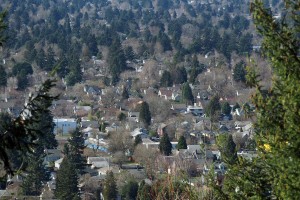 Here’s a patch of Northeast Portland, seen from Rocky Butte. Many years ago, a Dutch friend of mine came to visit Portland. He never could get over the sight of so many trees growing all over everywhere. This shot compacts them quite a bit, but it’s true. This is the city, not the countryside. If not for the trees, you’d see only houses.
Here’s a patch of Northeast Portland, seen from Rocky Butte. Many years ago, a Dutch friend of mine came to visit Portland. He never could get over the sight of so many trees growing all over everywhere. This shot compacts them quite a bit, but it’s true. This is the city, not the countryside. If not for the trees, you’d see only houses.
Trees are so sacred to Portlanders that the city recently made it illegal to trim them without the guidance of a professional arborist.
 Downtown Portland’s waterfront, along the Willamette River, is a long, stringy, park. At lunch time, it brims with walkers, joggers, and cyclists.
Downtown Portland’s waterfront, along the Willamette River, is a long, stringy, park. At lunch time, it brims with walkers, joggers, and cyclists.
This part of the waterfront is dedicated to Japanese-Americans. It’s located not far from the old “Japantown,” which no longer exists. Various monuments call to memory the way these citizens were mistreated during World War II. It’s good to keep such self-critical monuments in the public eye, even if most people are jogging by too fast to read them.
I recall a string of self-critical monuments along the waterfront in Bonn, Germany, bringing to mind the World War II excesses in that country. I’ve never seen any self-critical memorials in China, but perhaps I just haven’t looked hard enough yet.
 Yes, there is a Chinatown in Portland. But unlike its sisters in Oakland and San Francisco, there’s not much to write home about. For one thing, there are hardly any trees. For another, there’s no block jammed with Chinese grocery stores. Still, it does have an impressive gate. I suspect, though, that not many of the city’s Chinese citizens live there.
Yes, there is a Chinatown in Portland. But unlike its sisters in Oakland and San Francisco, there’s not much to write home about. For one thing, there are hardly any trees. For another, there’s no block jammed with Chinese grocery stores. Still, it does have an impressive gate. I suspect, though, that not many of the city’s Chinese citizens live there.
 And then there’s Powell’s City of Books. They spent a year remodeling the main entrance on the corner of Burnside and NW Tenth Avenue. Powell’s is one of the truly great booksellers, its main store one of the largest anywhere. It was the first book shop (that I know of) which, decades ago, installed a coffee shop for the convenience of browsers.
And then there’s Powell’s City of Books. They spent a year remodeling the main entrance on the corner of Burnside and NW Tenth Avenue. Powell’s is one of the truly great booksellers, its main store one of the largest anywhere. It was the first book shop (that I know of) which, decades ago, installed a coffee shop for the convenience of browsers.
Now the entire front room is encased in wrap-around windows. The effect is to draw the outer environment into the store, along with lots of customers. Any book lover who visits Portland owes it to themselves to visit Powell’s.
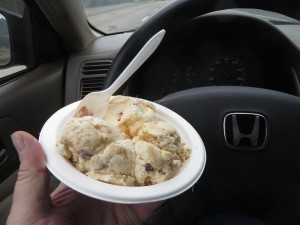 As for me, I spent a lot of time visiting family, and sleeping. For some reason, I really slept well up there. And I even got home-cooked meals from my mother. It was a thousand-kilometer drive each way, but it was worth it.
As for me, I spent a lot of time visiting family, and sleeping. For some reason, I really slept well up there. And I even got home-cooked meals from my mother. It was a thousand-kilometer drive each way, but it was worth it.
And I even stopped in Rice Hill, Oregon, each way for some scoops of that classic Umpqua ice cream.
The Way Back
So, in three days, I’ll be wending my way back to the CCP, the Chinese capitalist paradise. No one has thought to inform me of my teaching schedule, but that’s pretty normal. I suspect that I’ll start teaching again sometime around the eighth or ninth of March. We’ll just have to wait and see. Usually I nag them until somebody tells me. This semester, I got tired of that. I wonder if they’ll let me know before or after my first class takes place?

It’s a pretty good thing I’m going back. As usual, I gained lots of weight while in America. It’s much easier to eat more moderately in China. Hopefully that’s what’s going to happen. I’m also hoping to be doing a lot more walking (on days when the pollution is not severe).
As always, I welcome any communication. Somebody asked me the other day what the hardest part of living in China is. I had to answer that it’s the fact that so little communication ever takes place there.
One of my Chinese colleagues recently asked me to compare the students’ English to the state of English in general in China. I had to answer that, except for my own students and a couple Chinese wives married to Americans, almost no Chinese person ever speaks English to me (or for that matter, communicates at all), including most of the English teachers, so how can I judge?
Anyway, I’ll close with one more beautiful scene from our lovely Pacific Northwest, taken through the windshield on my drive from Portland. That’s Mt. McLoughlin, another old volcano, in the background, and the Rogue River Valley near Central Point in the foreground. What you don’t see, of course, is that crystal-clear air, through which you can see not just for miles, but for tens of miles.



